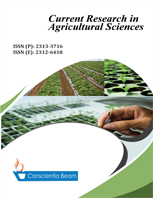Insecticide Spraying Regime to Control Insect Pest of Cowpea: Management and Monitored Application of Cypermethrin in Lomami Province, DR Congo
DOI:
https://doi.org/10.18488/journal.68.2019.61.37.53Abstract
Cowpea is one of the most important grain legumes growing in Lomami province, DR Congo. Despite the high potential for production in this region, insect pests are the main problems of cowpea producers. They most often belong to the following categories: pod borers (Maruca vitrata), pod-sucking bug (PSB) complex of which Riptortus dentipes and Apium varium. A study was conducted to evaluate the efficacy of three spray regimes of Cypermethrin on the density of M. vitrata, A. varium and R. dentipes and the performance of yield components of cowpea. Trials were conducted at three different sites, one controlled (INERA) and two peasant sites (Mpiana and Yamba). Three genetically improved varieties called Mujilanga, CNGKASC2-1-1-T, and CNGKASA7-2-M of cowpea were used. The tests were conducted using a split-plot device with three repetitions. Results demonstrate that Cypermethrin is effective against insect pests of cowpea, the population of all target pest were found to decrease in the plot treated to the untreated plot. Application of insecticide three times recorded the highest increased grain yield between 93 and 169 %. The average yield for spray regime recorded 689.1 kg, 651.8 kg and 553.3 kg for D1, D2 and D3 sprays. Famers can use two or three spray regimes of Cypermethrin to manage the pest, this option may reduce the cost, in order to achieve a sustainable level of agricultural and a high level of environmental and human health protection in cowpea field in DR Congo.

